| Please access the following URL if you want to secure using SSL. All pages in the site will be secure pages. |
https://secure02.blue.shared-server.net/www.fish-food.co.jp/message english 3.2024.html |
Welcome to FISH FOOD TIMES
Mar. 2024 issue No.243

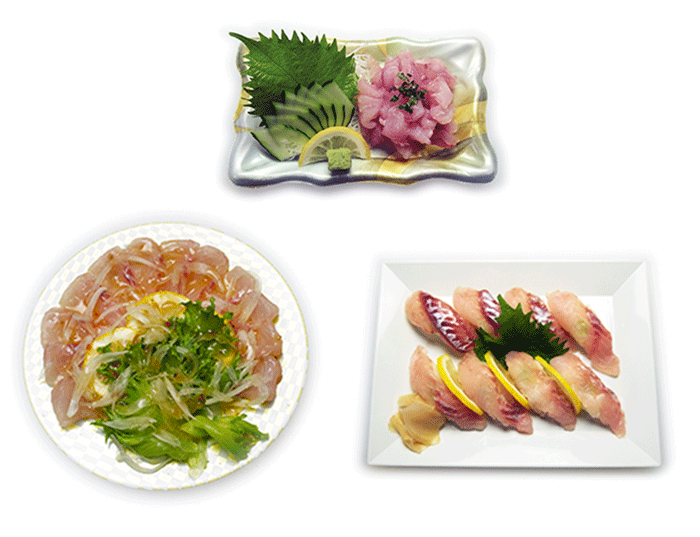
Brushtooth lizardfish eaten raw
Delicious fish not sold in the fish department
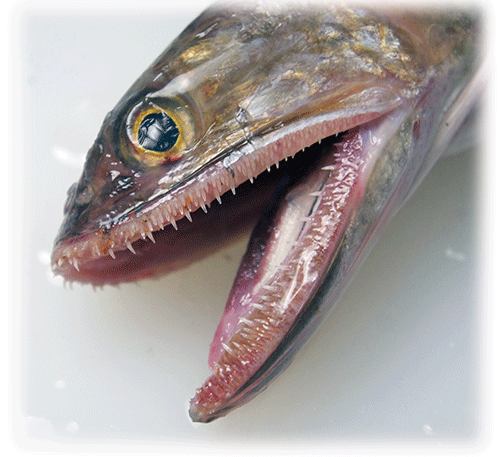
It seems that not many people would be able to immediately guess what kind of fish it is when they see this image of the fish with its sharp, crocodile-like teeth exposed. It is safe to say that it is rare to see it at a fish store so that it can be described as such.

Its true identity is a brushtooth lizardfish. There is a fish of the same genus called the wanieso lizardfish, which looks exactly like this brushtooth lizardfish and can only be distinguished by the color of its tail fin. Although these are different species, they are often treated as the same fish without being distinguished from the brushtooth lizardfish.
The meaning of brushtooth lizardfish in kanji is something like ugly or boring. Brushtooth lizardfish have long been said to be "a snake in disguise, or a toad in disguise.'' If you look at the image below, it certainly looks like a snake's head, and it also resembles a frog's face.
.gif)
Even if there are fish with these descriptions lined up in a fish store, most people would probably find the appearance creepy, and very few people would salivate because they looked delicious. In other words, fishmongers do not want to carry brushtooth lizardfish in their products because customers might view them that way. This may be one of the reasons why brushtooth lizardfish are rarely found in fish stores.
The brushtooth lizardfish is a saltwater fish in the genus Saudida, order Aulopiformes and family Synodontidae. As shown in the image above, it has large eyes, a mouth, and sharp teeth, and seems to feed on small fish, crustaceans, and shellfish. The size is usually around 30 to 40 cm, but some can grow up to 70 cm. Its habitat is the Pacific Ocean south of Chiba Prefecture, and the Sea of Japan coast southwest of Wakasa Bay, where it lives in sandy soil at a depth of about 100 meters.
Brushtooth lizardfish has high-quality white flesh with no taste, but its biggest drawback is that it has many small bones. The small bones are also separated into two parts, the dorsal and ventral parts, so after the three pieces disassembly, many small bones need to be removed. Because the small bones are thick and strong, it is not appropriate to bone cut them into sashimi or sushi like conger pike.
The reason why brushtooth lizardfish are not commonly found in fish stores is not only because of their poor appearance as mentioned above, but also because they have many small bones that make them difficult to handle. Brushtooth lizardfish takes time and effort to prepare, so the price at the fish market is quite low. Many of the brushtooth lizardfish that are caught are used as ingredients for kamaboko (fried fish paste) and other fish paste products, so they are almost all bought up by fish paste manufacturers.
History and characteristics of kamaboko (fried fish paste)
Apparently, catfish was used as an ingredient for kamaboko during the Muromachi period. In the Edo period, conger pike was considered the best ingredient, and most white fish such as sea bream, tilefish, flathead, goby, and rockfish were also used.
During the Meiji period, Japanese bluefish, perch, and brushtooth lizardfish seemed to have become the main fish, but these stocks gradually depleted, and toward the end of the Meiji period, trawling fisheries were started in the East China Sea. Later, white croaker, drumfish, brushtooth lizardfish, cutlassfish, conger pike, and sharks began to replace the previous nearshore species. The catch of this "Isei fish" also decreased over time, and in the 1950s, frozen ground meat from Alaska pollack from the North Sea appeared as an alternative. Today, in all regions of Japan, the majority of kamaboko ingredients are made from Alaska pollack.
It is said that the name "Kamaboko'' came from the fact that the material is rolled into a cylinder around a bamboo stick, and the shape resembles a broadlear cattail. When the bamboo is removed, it takes on the shape of the current chikuwa, but "ita kamaboko'', which was formed on a board, appeared and was called "chikuwa kamaboko'' to distinguish it. In the original version, the "kamaboko'' was removed and became simply "chikuwa,'' and in the itakamaboko, the ita (board) was removed and became "kamaboko.''
Since long ago, white-fleshed fish was expensive, so kamaboko was also considered a feast, and they were used as gifts and as osechi dishes for the New Year. Kamaboko began to be sold as a product during the Edo period, and it is said that production began as a food industry after the Meiji period. The Japanese Agricultural Standards and Quality Labeling Standards classify kamaboko into 1) steamed kamaboko, 2) baked kamaboko, 3) chikuwa, 4) flavored kamaboko, 5) boiled kamaboko, 6) fried kamaboko, 7) special packaging kamaboko, and 8) crafted kamaboko.
When fish meat is ground with salt, the proteins dissolve and bind together in a network, and when this is heated, the network becomes even stronger, giving it a unique texture. This texture is called "ashi'' and influences the commercial value of kamaboko. In order to give this chewy texture, relatively inexpensive kamaboko is also added with starch.
I have heard from my wife that some cheap kamaboko containing a lot of starch are actually so poor that cats will exhibit "neko matagi (foods that even cats don't like to eat)''. This is a true experience that my wife experienced a long time ago. At the time, she tried to feed the cat her parents owned at the kamaboko shop in front of her house. However, when the cat smelled the kamaboko, the cat hated it and did not eat it. So, in exchange, she offered the cat some expensive kamaboko that she had bought from another shop, and the cat happily ate it. After hearing this story, it seems that cats can tell the quality of kamaboko using their sense of smell, but what about humans? At 98 yen each, you may be happy to eat Neko Matagi Kamaboko, calling it delicious, but you should be careful not to let your sense of smell and taste become worse than that of a cat.
In general, fish paste products are easily putrefied by bacteria and mold, so they must be kept refrigerated, and the indicated shelf life is often about 1 to 2 weeks, and at most 3 weeks. However, once the package is opened, it is recommended to eat it within one to two days, and the best way to enjoy it deliciously and safely is to eat it within 24 hours.
Among the many fish that can be used as kamaboko ingredients, brushtooth lizardfish maintains a stable taste throughout the year, and its surimi has a moderate elasticity, strong flavor, and a beautiful white color. In short, brushtooth lizardfish fulfills all the requirements for delicious kamaboko. For this reason, kamaboko made with brushtooth lizardfish is considered a luxury item and is said to be the king of kamaboko materials, and is known as the highest quality kamaboko material.
Kamaboko made with 100% domestic brushtooth lizardfish
A product called Murashiro, made and sold at the Murata Kamaboko store in Hagi City, Yamaguchi Prefecture, is made using 100% fresh domestic brushtooth lizardfish, which is the highest quality kamaboko. The image below shows it.
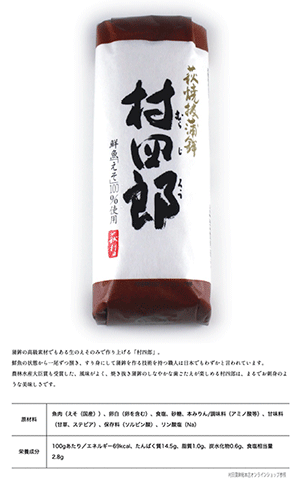
The author was interested in this product and searched for it at stores in and around Fukuoka City, but unfortunately none of them had it. All that was sold were cheap kamaboko in the 100 to 200 yen range. Most of the products' raw materials were simply labeled as fish meat, and it was unclear exactly what kind of fish they were using.
Murashiro is sold at 140g for 900 yen at an online shop. This time, even if I ordered online, I found out that it would not be delivered by the deadline for updating the website, so I did not purchase Murashiro.
In the end, after desperately looking for Murashiro, I finally gave up on looking for it at the last store and ended up purchasing Ginrou, a kamaboko from the same Murata kamaboko store. This was 300 yen for 110g, but a 160g product was sold for 500 yen at an online shop.
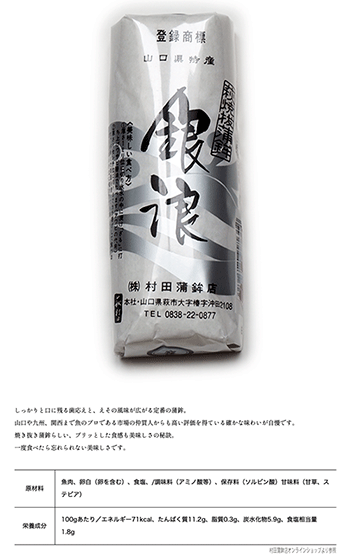
I think this product called Ginrou will be familiar to those involved in fish retail in Fukuoka. When I first started working in the seafood retail industry about 50 years ago, I remember that Ginrou kamaboko was always available at the many fish shops that still existed.
Therefore, I decided to think about why Ginrou kamaboko was a standard item in fish shops at the time. This is just my speculation, but Murata Kamaboko Store, which was founded in 1963, has a short history compared to other companies in the same industry. For this reason, it must have been extremely difficult for Murata Kamaboko Shop to break into existing competitors that have been around since the Meiji and Taisho eras and develop a wholesale delivery route to Japanese restaurants and Japanese-style inns.The company's founding president then focused on the fish market's wholesale route, which had not been rigidly established by competitors, and probably developed the business from there. As the online shop's product comment section states, "It has received high praise from market brokers,'' I believe that by developing this route, Ginrou has become a kamaboko that is familiar to fishmongers.
Although I have never sold Ginrou, nor have I particularly recommended to anyone involved, I continue to have an image of Ginrou as a product that is inseparable from fishmongers. Therefore, this time, although I don't know how much brushtooth lizardfish is in Ginrou, I decided to introduce it to my readers who are also involved in fish retail as an alternative to the 100% brushtooth lizardfish Murashiro.
In the image below, the Ginrou kamaboko on the board has a pure white color, and it is clearly labeled that no starch is mixed in.
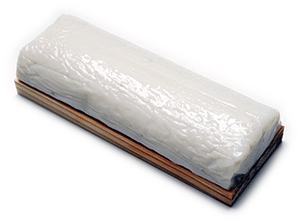
I created this as follows.
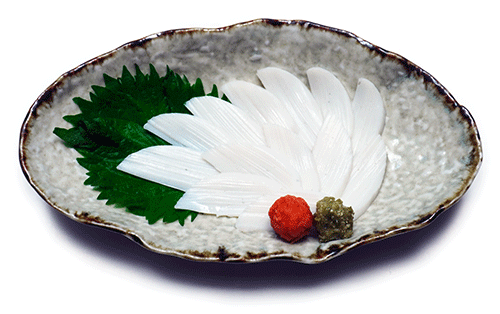
The wrapping paper that wraps Ginrou Kamaboko recommends cutting it into pieces about 1cm thick in the delicious way to eat it. However, since I am a twisted person, I made a thin "namigiri (wave cut)'' with the idea that I would eat it with momijioroshi and ponzu sauce, and also with raw true wasabi on top. After all, it is silver "wave (nami)"...
This momijioroshi is made by grating daikon radish and adding akaoroshi, which is made from grated domestic red chili peppers. If I may say so myself...it's "extremely delicious, exquisite momijioroshi." It's similar to the tube-packed momijioroshi, but since you can freely set the level of spiciness of the homemade momijioroshi, it's a completely different world of authentic momijioroshi, and you can enjoy not only the sashimi but also the kamaboko.
Working process for eating brushtooth lizardfish
Well, that's all I'll say about kamaboko, and I'll write about the main topic, brushtooth lizardfish.
As mentioned above, the biggest drawback of brushtooth lizardfish is that they have many small bones. Since the ossicles are arranged in two rows, it is troublesome to have to remove these ossicles afterwards even if you do normal three-piece disassembly. Moreover, the small bones are thick and strong, and there are many of them, which makes it a problem.
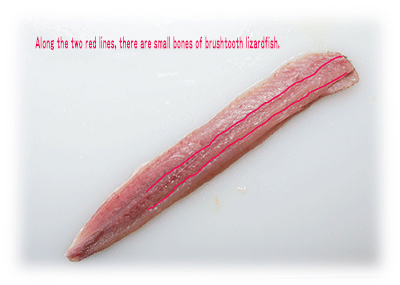
Generally speaking, when making fish into sashimi or sushi, even one bone should not be allowed to remain. Therefore, I think it is fair to say that brushtooth lizardfish, which has many small bones, is almost never eaten as sashimi or sushi. In that sense, the articles in this month's issue of FISH FOOD TIMES may become valuable materials that are hard to find elsewhere.
The image below is an image of the author who cooked brushtooth lizardfish in 2017 and kept it in stock without using it for a long time. Using this image, I would like to introduce the process for making brushtooth lizardfish into sashimi or sushi. However, let me tell you the truth about why I have been storing these images away for seven long years without using them. The reason for this is that I actually had a hard time removing the brushtooth lizardfish bones, and there were things that looked bad during the process, so I was reluctant to show these images to an unspecified number of readers.
However, this time I thought that if someone tried cooking brushtooth lizardfish, they would end up with something similar unless they were very familiar with it. In a sense, I decided to ask readers to look at the following material as a concrete example of "teacher by negative example."
| Brushtooth lizardfish three pieces disassembling work process | |
|---|---|
 |
 |
| 1,The brushtooth lizardfish I purchased was a large fish, about 55cm long. Make a cut from the pelvic fin to the dorsal side of the head. | 6,Since there are a lot of small bones, use the daimyou disassembling method using a deba knife. For this purpose, make incisions on both sides of the dorsal fin. |
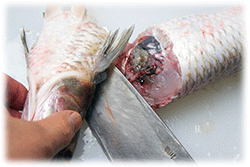 |
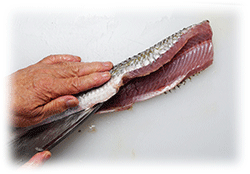 |
| 2,To cut off a brushtooth lizardfish's head, I recommend cutting from the ventral side to the dorsal side. | 7,Make a notch near the anal fin on the lower body. |
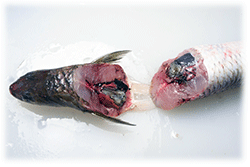 |
 |
| 3,The head and body were separated, leaving not only the pectoral fins but also the pelvic fins on the side of the head. | 8,Perform daimyou disassembling along the notch of the dorsal fin and anal fin. |
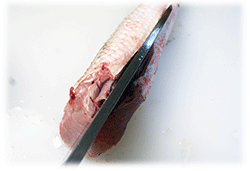 |
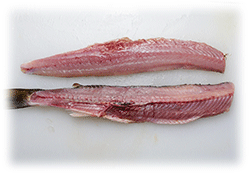 |
| 4,Make an incision in the abdomen and remove the internal organs. | 9,The state after two pieces disassembling. |
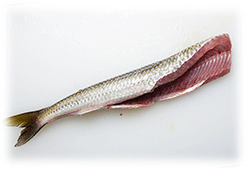 |
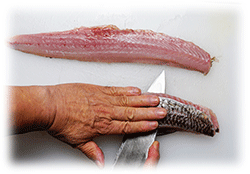 |
| 5,After removing the internal organs and wiping off the moisture. | 10,Next, use the same daimyou disassembling method to cut open the upper body and make three pieces disassembling. |
When disassembling three pieces of elongated spindle-shaped fish, it is usually smoother and easier to disassemble it with a yanagiba knife. However, in the case of this brushtooth lizardfish, it is a relatively large fish and is full of small bones, so I decided to use a deba knife to daimyou disassembling it.
The image below shows the key part of cooking brushtooth lizardfish, and it was a really tricky and difficult process. This time, the author expresses the method of ”commercializing brushtooth lizardfish to be eaten raw'' in one go. However, since this was seven years ago, my memory may be fuzzy in many details, so I may be expressing it incorrectly. I would appreciate it if you could read on with an open mind regarding this matter.
| Commercialization of brushtooth lizardfish for raw consumption | |
|---|---|
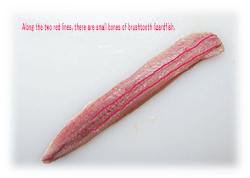 |
 |
| 1,The lower body was made into three pieces disassembling. There are countless small bones along the two red lines. | 8,The bottom of the three pieces disassembling after the skin removal. The reddish subcutaneous fat unique to white fish appeared. |
.gif) |
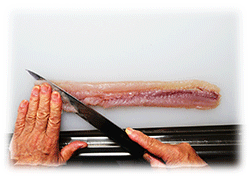 |
| 2,Use a yanagiba knife to make a long V-shaped cut along the row of small bones on the back body. | 9,For sushi material and carpaccio salad, cut thinly from the tail end. A craftsman who constantly dismantles brushtooth lizardfish prefers to use the tail, which has fewer small bones, when eating brushtooth lizardfish as sashimi. |
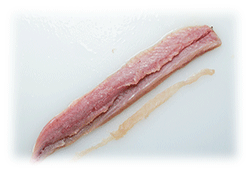 |
 |
| 3,A state in which the small bones of the back body are cut into a V-shape and a row of small bones, including fish meat attached to the small bones, are removed. | 10,Cut towards the head and choose the part with the best shape to use as the sushi material. |
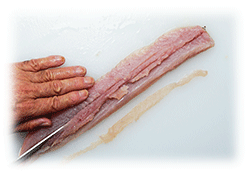 |
 |
| 4,Furthermore, make a V-shaped cut with the yanagiba knife along the row of small bones on the belly. | 11,After cutting usutsukuri, select the ones that are relatively unshaped and use them for carpaccio salad. |
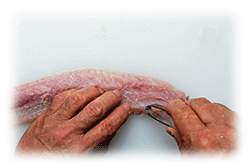 |
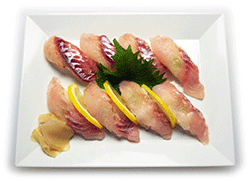 |
| 5,Since the V-shaped cut of the yanagiba knife cannot completely remove the small bones, use a bone removal tool to remove all of the small bones without worrying about some fish meat remaining on the bones. | 12,The result is a nigiri sushi that has a round indentation on the underside of the half body, so you won't feel that it's missing. |
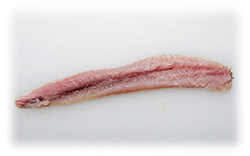 |
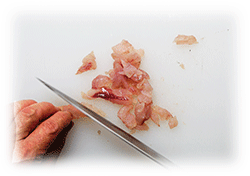 |
| 6,When I thoroughly removed the small bones using a bone removal tool, I ended up with a long, narrow depression like this. This is an image that I don't really want to show, but it's highly likely that it will end up like this. | 13,It can't be helped that there will be parts with bad shapes, so cut them all at once into cubes. |
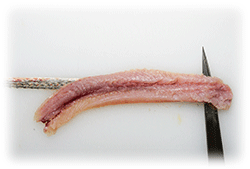 |
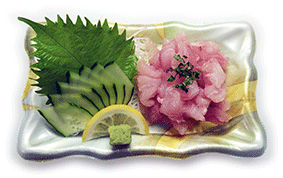 |
| 7,Do the skinning. | 14,The finely chopped parts were collected and made into sashimi. |
Delicious, misunderstood white fish
Until then, I had been aware that brushtooth lizardfish was a cheap fish that was sold at a low price as a fish for kamaboko. However, after actually eating brushtooth lizardfish raw, I was able to understand that it is a very delicious fish that is different from other cheap, popular fish. Fish shops simply don't buy the brushtooth lizardfish because it's difficult to handle and eat raw. Brushtooth lizardfish itself is a truly delicious white fish, and its true value, coupled with its appearance, seems to be a fish whose true value is not properly appreciated and is misunderstood.
Brushtooth lizardfish are mainly caught using small bottom trawl nets in various prefectures in western Japan. In addition to this, there is also fishing by bottom trawling. According to the National Fisheries Research and Education Agency's FY2020 Resource Assessment Report (digest version), the total catch by bottom trawling in the West was over 300,000 tons in the 1960s. However, in the first half of 1970, it was about 200,000 tons, and since then it has gradually decreased, dropping below 10,000 tons to 3,700 tons in 2019, of which the catch of brushtooth lizardfish in 2019 was 180 tons. At this point, the brushtooth lizardfish resource was at a low level and leveled off, but it is unclear what happened after that as there is no data available.
Although it cannot be said that brushtooth lizardfish resources are abundant in the waters around Japan, it does not appear that the resources are on the verge of depletion. Even if brushtooth lizardfish will not be landed in large numbers in the future, there is a possibility that they will be listed on fish markets little by little.
If you, our readers, have the opportunity to come across a brushtooth lizardfish, please try eating it raw, even if you have a hard time removing the small bones. Once you understand the superior taste, you should offer it to your customers and share the deliciousness with them.
| Please access the following URL if you want to secure using SSL. All pages in the site will be secure pages. |
https://secure02.blue.shared-server.net/www.fish-food.co.jp/message english 3.2024.html |
An opinion and the communication are to iinfo@fish food times
Date of updating 1 Mar. 2024
